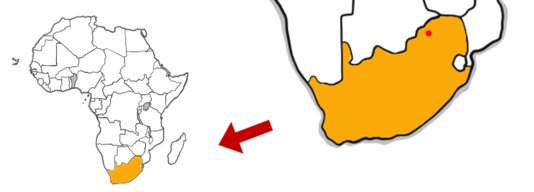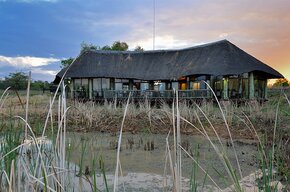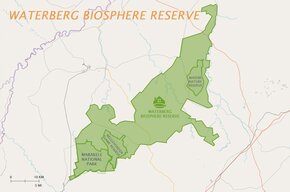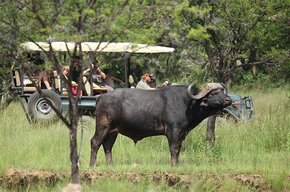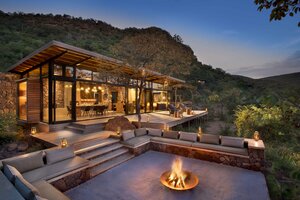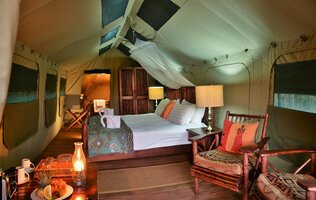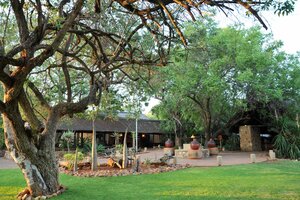Overview
Waterberg Biosphere Reserve is a UNESCO conservation project that is part of the greater ecosystem. The conservatory area is home to various species of wild animals and offers a comprehensive game viewing experience.The Biosphere operates in collaboration with different settlements and reserves to restore wildlife habitat and human development. For tourists, the region offers various game reserves such as the upmarket Welgevonden private game reserve, highly regarded Lapalapa wilderness area and Marakele National Park, along with various other reserves and lodges.Why Go:
- The region offers a beautiful and rugged scenery
- Various lodging options, which include private reserves, bush camps, and parks to choose from
- Tourists are offered a range of outdoor activities, such as mountain biking and horseback riding
- Tourists have a self-drive option at the Waterberg Meander route
- Excellent place for bird viewing along with hundreds of species
- The region is safe for children, as it is Malaria-free
Wildlife
Wildlife viewing is diverse in the region and offers a mix of domesticated and wildlife animals. The largest reserves in the region are Welgevonden and Marakele that offer big-five safaris.Welgevonden is an ideal private game reserve with plenty of big five safaris, while Marakele is primarily a self-drive destination. The two reserves are separated by a fence, which may be removed to progress the conservation agenda.Tourists can explore the various farms and reserves and view different species of animals. However, some reserves only have grazing animals with outdoor activities such as horse riding and mountain biking.
More About the WildlifeScenery
The large plains have three types of habitats that include wetlands, sour bushveld, and mountain slopes. It is commonly referred to as the ‘Waterberg Moist Mountain Bushveld Savanna’.
Best Time to Visit
The best time to visit Waterberg Biosphere Reserve is during the winter-dry season, which is from May to September. The vegetation is thin and dries, causing a concentration of animals around waterholes.
More About the Best Time to VisitWeather & Climate
Waterberg Biosphere Reserve’s weather and climate are quite similar to the weather of South Africa.
More About the Weather and ClimateWildlife & Animals
Many large animals have been introduced, including lion and buffalo, but numbers are still low. White rhino is spotted regularly, and black rhino is present, but rarely seen. Several interesting antelope species can be encountered, including the rare tsessebe.
Elephant
Occasional
Giraffe
Common
Hippo
Occasional
Buffalo
Rare
Zebra
Common
Wildebeest
Common
White Rhino
Common
Black Rhino
Rare
Lion
Rare
Leopard
Rare
Cheetah
Rare
Hyena
Rare
Wild Dog
None
Wildlife highlights
The rederve is home to as many as 16 antelope species due to its variety of habitats. Some of the specials include reedbuck, mountain reedbuck, eland, tsessebe and the stately sable antelope. A night drive offers a chance to see the elusive aardwolf and aardvark.Best time for wildlife viewing
A visit to view wildlife in Waterberg Biosphere Reserve is better scheduled during the Dry season. At this time, water in the bush dissipates leaving animals to search for available water. These sources of water are great for spotting wildlife, and the sparse plant-life make it all the easier to do so. The Dry season occurs from June to September.Best Time to Visit
- Best Time to GoMay to September
(Dry season) - High SeasonNever
(The park is little visited)
May to September
Dry season
Never
The park is little visited throughout the year
Never
The park is little visited throughout the year
April to May
Mild weather and little rain
September to October
Mild weather and little rain
May to August
Chilly mornings and nights
December to February
Hot and afternoon rain
May to September
- Dry Season – WinterOctober to April
- Wet Season – SummerWeather & Climate
The wet summer months (October to April) are hot. Dry winters (May to September) are moderate during the day, but cold at night and in the morning, making the packing of warm clothing essential.Climate Chart
- 807-2,100m / 2,648-6,890ft© chart & park data: SafariBookings. © climate grid data: WorldClim project. All rights reserved.
Dry season
- May to September – WinterThe dry winter season is from May to September, which is also the best time to visit Waterberg Biosphere Reserve.
Wet season
- October to April – SummerOctober to April is the wet summer season and temperatures can increase to uncomfortable levels.
Getting There
The Waterberg is located about 250km/124mi north of Johannesburg. Your point of entry into South Africa will most likely be O.R. Tambo International Airport (JNB) in Johannesburg, where you can rent a 4WD and drive on to Waterberg.Getting to the Waterberg Biosphere Reserve by air
There are multiple flights to O.R. Tambo International Airport (JNB) in Johannesburg. If you want to check ticket prices, you can log on to:
www.skyscanner.comwww.expedia.com
Charter flights are generally arranged by your tour operator as an inclusion to your safari package.
Getting to the Waterberg Biosphere Reserve by road
After a major rehabilitation project of the road network in the park in 2016, most of the roads are now passable in a 2WD car. The trip from Johannesburg will take you about 3 hours.

